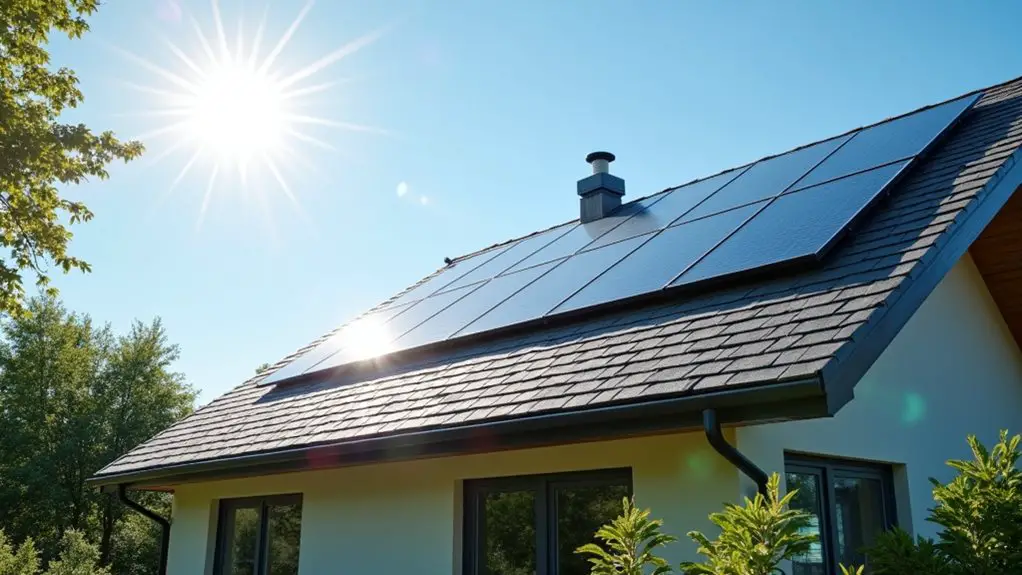Why Choose Energy-Efficient Roofing Materials?

When considering a roofing upgrade, energy-efficient materials should be at the top of your list. They not only help lower your energy bills but also enhance your home’s comfort through better thermal regulation. Plus, many of these options are designed with sustainability in mind. But what other benefits do they offer? Let’s explore the various advantages that make these materials a worthwhile investment for your home.
Energy Savings Benefits
When you choose energy-efficient roofing materials, you not only enhance your home’s comfort but also can greatly reduce your HVAC usage and energy costs. These materials help lower heating and cooling bills by minimizing heat transfer, allowing you to enjoy a cozy environment without breaking the bank. By using reflective roofing, you can decrease sun absorption, which considerably lowers your cooling needs in the hot months. Plus, proper insulation will help retain warmth during the winter, keeping your space inviting. The beauty of these investments is that the energy savings add up over time, making your choices a smart financial decision. Energy-efficient roofs not only contribute to your home becoming an inviting sanctuary but also help you connect with a community that values sustainability and savings.
Thermal Regulation Advantages
While selecting roofing materials, you can greatly enhance your home’s thermal regulation capabilities. By opting for reflective technologies, like high solar reflectance coatings, you can reduce heat absorption by up to 65%. Cool roofs can keep surface temperatures 50–60°F lower during peak sunlight hours. Pairing materials such as clay or concrete tiles with synthetic underlayments can stabilize indoor temperatures, absorbing and releasing heat effectively. Metal roofing can lower attic temperatures by 20–25°F thanks to its reflective surfaces. Incorporating insulation synergies, like radiant barriers and above-sheathing ventilation, amplifies thermal resistance, keeping your home comfortable year-round. Additionally, the use of high thermal mass materials can help absorb daytime heat and release it slowly at night, further contributing to indoor climate stability. With thoughtful choices, you’re not just upgrading your roof; you’re creating a more inviting and sustainable haven for you and your family.
Environmental Impact Considerations
Choosing energy-efficient roofing materials not only benefits your home but also has a significant positive impact on the environment. By opting for materials like metal, you extend product lifespan, which cuts down on replacement frequency and resource consumption. Integrating solar roofs allows you to harness renewable energy, reducing dependence on non-renewable sources. Plus, many roofing materials can be recycled, keeping waste out of landfills and lowering the need for virgin resources. With high solar reflectance, energy-efficient roofs minimize heat absorption, easing your cooling demands. As your HVAC system works less, you reduce fossil fuel use at power plants, helping preserve our natural resources. Together, these choices make a difference for both your home and our planet. Moreover, selecting sustainable roofing options not only promotes energy conservation but also contributes significantly to reducing overall environmental footprints.
Material Composition Insights
Understanding the composition of roofing materials is essential as it directly impacts your home’s energy efficiency and longevity. By selecting the right materials, you not only enhance your comfort but also contribute to a more sustainable community. Consider these elements that make energy-efficient roofing stand out:
- Polymer blends: Use recycled materials for sustainability and high performance.
- Metal options: Reflective coatings offer long-lasting protection against rust and heat.
- Tile variants: Natural materials enhance aesthetic appeal while ensuring effective insulation.
- EPDM membranes: Seamless installations increase efficiency and lower energy costs. Energy-efficient roofing options are designed to reflect more sunlight and absorb less heat, helping your home stay cooler and reducing energy bills.
Choosing energy-efficient roofing provides not just a practical upgrade; it cultivates a sense of belonging in the effort to build a greener and more responsible future together.
Structural Benefits of Energy-Efficient Roofing
Energy-efficient roofing brings a host of structural benefits that enhance your home’s durability and performance. By using lightweight materials, you reduce structural stress, preventing sagging while supporting both steep and low-slope designs. These roofs reflect up to 90% of solar radiation, stabilizing substrate temperatures and minimizing thermal expansion. With advanced interlocking systems, they withstand wind speeds up to 130 mph, while UV-resistant coatings maintain reflectivity for years. Plus, their longevity outpaces traditional options, offering a 50-year lifespan. Incorporating energy-efficient roofing seamlessly integrates with solar panels and improves ventilation, adding value to your home. Ultimately, these benefits unite to create a resilient, efficient space for you and your loved ones, contributing to reduced utility bills through decreased reliance on air conditioning in warmer months.
Financial Value of Upgrading Your Roof
Upgrading your roof can greatly impact your home’s financial value. Investing in a new roof isn’t just about aesthetics; it’s a strategic move. Imagine the benefits:
- Recoup 60-70% of installation costs, boosting your equity.
- Asphalt shingle roofs add about $17,800 in value.
- Metal roofs can increase value by $23,160 overall.
- Enjoy reduced utility costs with energy-efficient materials. A new roof also enhances your home’s structural integrity, making it more attractive to potential buyers.
Your home becomes not just a space to live, but an investment. A newer roof attracts potential buyers and eases their worries about repairs. Whether you’re planning to stay or move, this upgrade makes you feel secure and valued within your community. Don’t underestimate the financial and emotional payoff of a robust, energy-efficient roof.
